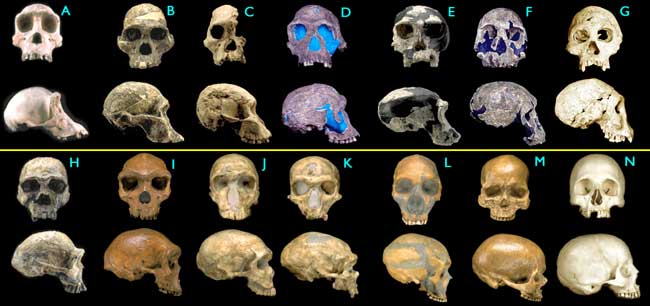
 |
Freethought & Rationalism ArchiveThe archives are read only. |
|
|
#1 |
|
Junior Member
Join Date: Jul 2003
Location: Chicago
Posts: 16
|
I am not very knowledgeable of the science of evolution, but I am looking for information to increase my understanding of the evidence for ancient hominids being ancestors to modern man. On what basis do scientists link modern man to hominid ancestors? Is it through bone similarities? Is it through tool making? Is it through bipedal locomotion? How do they argue that man came from a certain ancient hominid verses that ancient hominid developing into another species or just simply leading to a dead end?
|
|
|
|
|
#2 |
|
Veteran Member
Join Date: Jul 2002
Location: East Coast. Australia.
Posts: 5,455
|
Talkorigins always has good information.
This FAQ goes over the information for various known specimens, and includes these diagrams: A timeline of how various kinds of fossils are dated in relation to each other:  A smooth gradient of fossil skulls, with modern humans at the end:  As you can see, simply plotting the morphological features of the fossils on the timespans they are dated to makes it relatively obvious who our ancestors were in general. Working out the specifics of which lineage went where, diverged when, and hit what dead ends is much more fiddly, and draws on a variety of different kinds of evidence. Regardless of the fossil evidence for precisely which fossils are whose ancestors, we can tell through other means that we must have evolved from something. Things like Fused human chromosome #2, and endogenous retroviral fragments are stand-alone proof of common descent. |
|
|
|
|
#3 |
|
Veteran Member
Join Date: Jul 2001
Location: Dana Point, Ca, USA
Posts: 2,115
|
The reasons you gave, tool use, bipedal locomotion, bone morphology are good ones. What needs to be added to these is chronology.
On the molecular level, there are genetic phylogenies based on DNA and RNA samples of living primates, and neandertal fossils (RNA). Some of the more interesting data on the molecular level comes from endogenus retroviral fragments in primate DNA. Retroviruses reproduce by inserting their DNA into that of their host cell. The cell then makes copies of the virus. Sometimes the virus infects a stem cell that produces an egg, or sperm. These viral DNA are then inherited by later generations. The study of the mutations that accumulate in these non-coding DNA segments can be compared across species, and a phylogenetic map can be calculated. Some examples are: http://www.pnas.org/cgi/content/full/96/18/10254#Top http://vir.sgmjournals.org/cgi/content/full/80/10/2613 http://mbe.oupjournals.org/cgi/reprint/16/9/1198.pdf You will need to register (free!) for the PNAS articles. Everone involved with Evo/Creato debates should have accessed PNAS. |
|
|
| Thread Tools | Search this Thread |
|